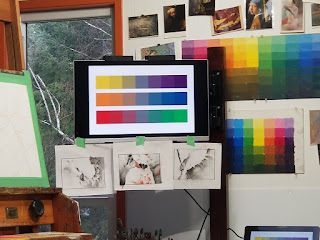There is a boldness and freshness about Marc's work that I have admired. His compositions and his methods for working with acrylics are unique. I was very please when an opportunity to attend one of his workshops became available. The workshop was held in Bracebridge at the Muskoka Arts & Crafts Inc. - a very nice facility.
The format for the workshop was
a bit unusual. Marc did a plein air demo each morning of about 2 hrs, then back to the
studio where we painted. Marc is most comfortable working on location
- and I would have enjoyed spending my painting time on location with him - but
others were not prepared for plein air - and the course description did not
indicate it. Still the afternoon sessions were good with lots of time given by Marc
to each participant.
Marc prefers sitting to work. He has much younger knees than mine.
Mark worked on masonite treated with coats of latex house primer - which he prefers over gesso as the surface is smoother and he feels his paint flows better. His initial plan is sketched using a rigger with a acrylics. He uses no mediums and seldom sprays his palette. He puts out small amounts of paint as needed and works on a disposable palette paper. He works with a limited palette working with two pairs of compliments making cool and warm grays.
He works from back to front. Once his plan is made he quickly builds under layer using a large soft brush. He layers until he gets the feeling he wants then switches to a rigger brush which he uses extensively throughout the painting. All his final stroke are with the rigger using paint that is quite thick adding texture and character.
His demos were excellent. Really fun to watch his process. He is able to add comment and answer questions as he works. His teaching in the afternoon was excellent as well - he is gentle and patient but critically honest as needed. I appreciated the suggestions he had for me.
Marc's work is full of energy. I love what he does with the rigger - wondering what it might do to add final physical energy to mine. I made four starts trying to add some of Marc's energy - but unable to control my love for colour.
I enjoyed this workshop and spending time with Marc. I rate his knowledge and skill as excellent. His teaching style as well. I recommend his workshops.


















































